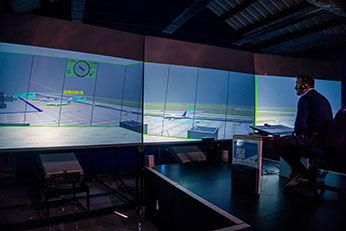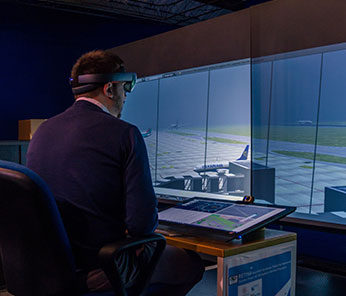The initial results from a SESAR-funded exploratory research project are showing the promise that augmented reality holds for enhancing air traffic control operations, particularly in low-visibility conditions. Tests carried out by partners in the RETINA (Resilient Synthetic Vision for Advanced Control Tower Air Navigation Service Provision) project demonstrated how these novel technologies can increase the situational awareness of air traffic controllers working in airport towers, allowing them to better manage traffic especially when bad weather sets in.
The first three batches of RETINA project validation exercises were successfully completed in November in the Virtual Reality and Simulation Laboratory at the University of Bologna, Italy. The validation platform set up at the laboratory was able to mimick the Bologna airport environment, a typical regional airport where low-visibility conditions regularly impact the operations’ to make it more concrete. There RETINA partners (Fig.1) tested a set of goggles (Hololens) through which controllers could see augmented reality 3D symbols overlaid on the out-of-tower view (Fig.3). The project validated the goggles by means of human in the loop real-time simulations where the out-of-the-tower view was provided to the controller in a semi-immersive reconfigurable virtual environment capable of simulating any type of weather/visibility condition on any airport with a high degree of realism (Fig.2).
The results confirmed the expected benefits in terms of:
- Increased situation awareness and increased head-up time and, as a consequence, increased safety, since the interface provides all needed information as head-up conformal symbols super-imposed to the out-of-the-tower view.
- More efficient operations especially in low visibility conditions, as the controller is provided with a head-up view of the air traffic similar to the enhanced vision currently used in the cockpit.
- Increased airport resiliency to low-visibility conditions as the overlays provided by means of augmented reality enhance the controller’s capabilities of managing air traffic in low-visibility conditions leading to overcome limitations on the airport capacity.
The validation outcomes confirm that the technology is mature enough be tested in a real operational setting, thereby demonstrating the effectiveness of the SESAR lifecycle, from innovation to solution.
The RETINA project brings together the following partners:
CRIDA, ENAV, Eurocontrol, Luciad, University of Bologna (Project Coordinator).


